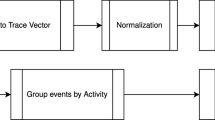Abstract
Outlier detection in process mining refers to either infrequent behavior in relation to the underlying business process models or to anomalous latencies of task execution (temporal anomalies). In this work, we focus on the latter form of anomalies and we propose distance-based methods. Compared to solutions relying on probability distribution analysis and based on the experimental evaluation presented, our proposal is shown to be capable of covering both trace and event outliers, and being more efficient and effective. More specifically, running times of our technique are lower by up to an order of magnitude, while we achieve significantly higher precision and recall.
Access this chapter
Tax calculation will be finalised at checkout
Purchases are for personal use only
Similar content being viewed by others
Notes
- 1.
If the logs contain the start and end finish time of each task explicitly, then our approach to detecting latency anomalies can be applied to detecting anomalous task durations in a straightforward manner.
- 2.
It is out of our scope in this work to compare R-tree vs M-tree.
- 3.
- 4.
- 5.
References
van der Aalst, W.M.P.: Process Mining - Data Science in Action, 2nd edn. Springer, Heidelberg (2016). https://doi.org/10.1007/978-3-662-49851-4
Aggarwal, C.C.: Outlier Analysis. Springer, Cham (2017). https://doi.org/10.1007/978-3-319-47578-3
Böhmer, K., Rinderle-Ma, S.: Multi-perspective anomaly detection in business process execution events. In: International Conference on Cooperative Information Systems (CoopIS) 2016, October 2016. http://eprints.cs.univie.ac.at/4785/
Böhmer, K., Rinderle-Ma, S.: Mining association rules for anomaly detection in dynamic process runtime behavior and explaining the root cause to users. Inf. Syst. 90, 101–438 (2020)
Borkowski, M., Fdhila, W., Nardelli, M., Rinderle-Ma, S., Schulte, S.: Event-based failure prediction in distributed business processes. Inf. Syst. 81, 220–235 (2019)
Ciaccia, P., Patella, M., Zezula, P.: M-tree: an efficient access method for similarity search in metric spaces. In: International Conference on Very Large Data Bases (VLDB) (2001)
Conforti, R., Rosa, M.L., ter Hofstede, A.H.M.: Filtering out infrequent behavior from business process event logs. IEEE Trans. Knowl. Data Eng. 29(2), 300–314 (2017)
Dai, Q.Z., Xiong, Z.Y., Xie, J., Wang, X.X., Zhang, Y.F., Shang, J.X.: A novel clustering algorithm based on the natural reverse nearest neighbor structure. Inf. Syst. 84, 1–16 (2019)
Hawkins, D.: Identification of Outliers. Springer, Netherlands (1980). https://doi.org/10.1007/978-94-015-3994-4
Hsu, P.Y., Chuang, Y.C., Lo, Y.C., He, S.C.: Using contextualized activity-level duration to discover irregular process instances in business operations. Inf. Sci. 391–392, 80–98 (2017)
Kang, B., Kim, D., Kang, S.H.: Real-time business process monitoring method for prediction of abnormal termination using KNNI-based LOF prediction. Expert Syst. Appl. 39(5), 6061–6068 (2012)
Knorr, E.M., Ng, R.T.: Algorithms for mining distance-based outliers in large datasets. In: Proceedings of the 24rd International Conference on Very Large Data Bases, pp. 392–403 (1998)
Knorr, E.M., Ng, R.T.: Finding intensional knowledge of distance-based outliers (1999)
Kueng, P., Kawalek, P.: Goal-based business process models: creation and evaluation. Bus. Process Manag. J. 3 (1996)
de Lima Bezerra, F., Wainer, J.: Algorithms for anomaly detection of traces in logs of process aware information systems. Inf. Syst. 38, 33–44 (2013)
Dumas, M., La Rosa, M., Mendling, J., Reijers, H.: Fundamentals of Business Process Management. Springer, Heidelberg (2019). https://doi.org/10.1007/978-3-662-56509-4
Nolle, T., Seeliger, A., Thoma, N., Mühlhäuser, M.: DeepAlign: alignment-based process anomaly correction using recurrent neural networks. In: Dustdar, S., Yu, E., Salinesi, C., Rieu, D., Pant, V. (eds.) CAiSE 2020. LNCS, vol. 12127, pp. 319–333. Springer, Cham (2020). https://doi.org/10.1007/978-3-030-49435-3_20
Rogge-Solti, A., Kasneci, G.: Temporal anomaly detection in business processes. In: Sadiq, S., Soffer, P., Völzer, H. (eds.) BPM 2014. LNCS, vol. 8659, pp. 234–249. Springer, Cham (2014). https://doi.org/10.1007/978-3-319-10172-9_15
Rosa, M.L., van der Aalst, W.M.P., Dumas, M., Milani, F.: Business process variability modeling: a survey. ACM Comput. Surv. 50(1), 2:1–2:45 (2017)
Satyal, S., Weber, I., Paik, H.Y., Ciccio, C.D., Mendling, J.: Business process improvement with the AB-BPM methodology. Inf. Syst. 84, 283–298 (2019)
Subramaniam, S., Palpanas, T., Papadopoulos, D., Kalogeraki, V., Gunopulos, D.: Online outlier detection in sensor data using non-parametric models. In: VLDB, pp. 187–198 (2006)
Toliopoulos, T., Gounaris, A., Tsichlas, K., Papadopoulos, A., Sampaio, S.: Parallel continuous outlier mining in streaming data. In: 5th IEEE International Conference on Data Science and Advanced Analytics (DSAA) (2018)
Yeung, D.Y., Chow, C.: Parzen-window network intrusion detectors. In: Object Recognition Supported by User Interaction for Service Robots, vol. 4, pp. 385–388 (2002)
Acknowledgment
The research work was supported by the Hellenic Foundation for Research and Innovation (H.F.R.I.) under the “First Call for H.F.R.I. Research Projects to support Faculty members and Researchers and the procurement of high-cost research equipment grant” (Project Number: 1052).
Author information
Authors and Affiliations
Corresponding author
Editor information
Editors and Affiliations
Rights and permissions
Copyright information
© 2020 Springer Nature Switzerland AG
About this paper
Cite this paper
Mavroudopoulos, I., Gounaris, A. (2020). Detecting Temporal Anomalies in Business Processes Using Distance-Based Methods. In: Appice, A., Tsoumakas, G., Manolopoulos, Y., Matwin, S. (eds) Discovery Science. DS 2020. Lecture Notes in Computer Science(), vol 12323. Springer, Cham. https://doi.org/10.1007/978-3-030-61527-7_40
Download citation
DOI: https://doi.org/10.1007/978-3-030-61527-7_40
Published:
Publisher Name: Springer, Cham
Print ISBN: 978-3-030-61526-0
Online ISBN: 978-3-030-61527-7
eBook Packages: Computer ScienceComputer Science (R0)




